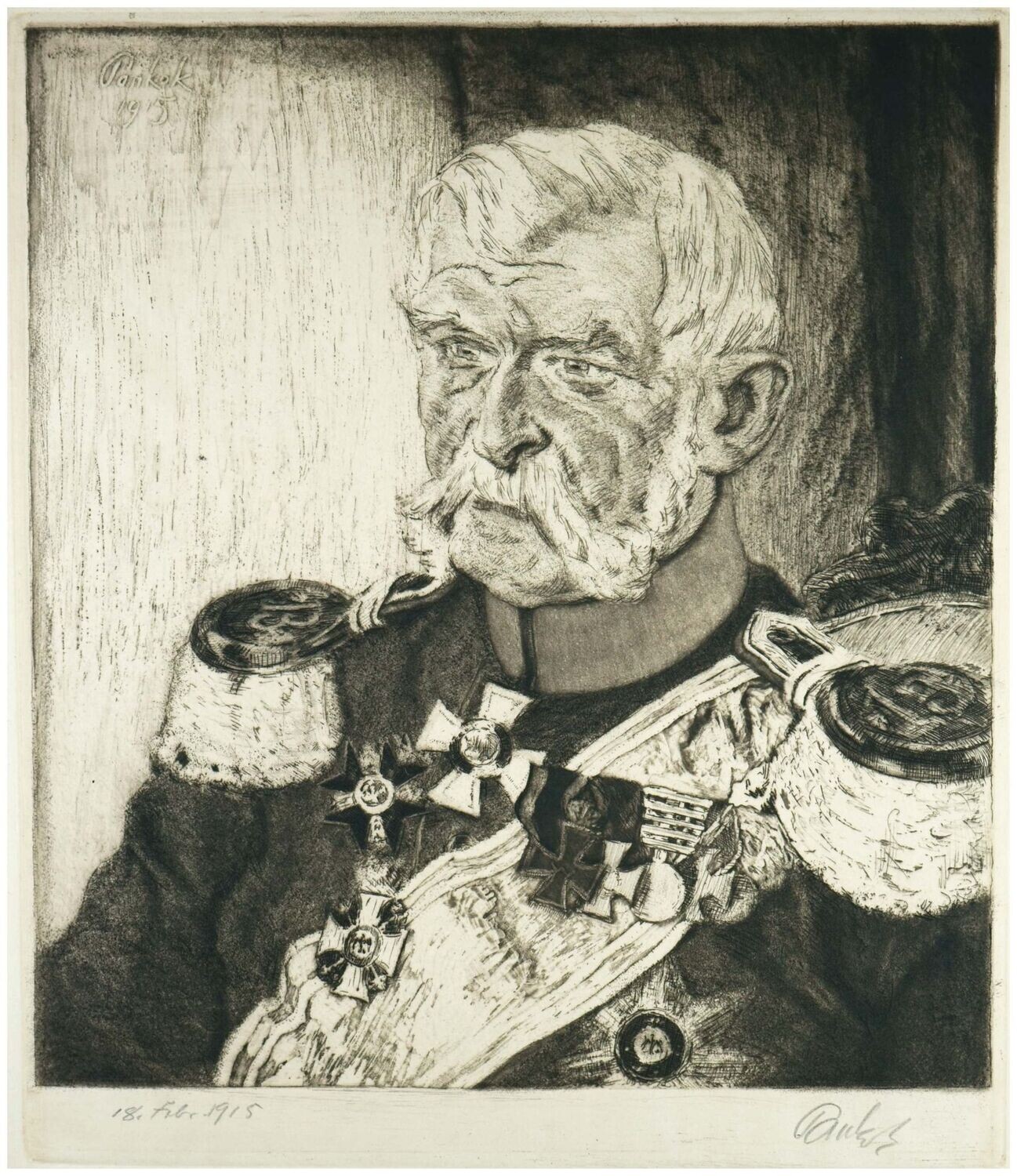Pankok, Bernhard (1872-1943), General Wilhelm von Blume, 1915
Bernhard Pankok(1872 Münster – 1943 Baierbrunn), General Wilhelm von Blume , 1915, Aquatintaradierung, 34 x 29,5 cm (Blattgröße), 26 x 22 cm (Plattengröße), links oben in der Platte, rechts unten in Blei signiert und unten links in Blei datiert.
- links unten alter Sammlungsstempel, am rechten breiten Rand mit kleinem Fleck, sonst in sehr gutem Zustand
- Visionärer Rückblick -
Die 1915 entstandene Aquatintaradierung des Generals Wilhelm von Blume geht auf ein Ölbild aus dem Jahre 1912 zurück, das sich m LWL Museum für Kunst und Kultur Münster befindet. Ein zweites Porträt des Generals in Öl aus der Hand Pankoks gehört der Staatsgalerie Stuttgart. Als Pankok 1912 das vorbildliche Ölporträt geschaffen hatte, befand sich der General bereits 16 Jahre im Ruhestand. Es handelt sich folglich um ein retrospektives Porträt. Dementsprechend ist die Ausrichtung des Kopfes so gewählt, dass er sowohl auf dem Ölbild als auch der Radierung zurückblickt. Ohne etwas Konkretes zu fixieren, sieht er sinnierend nach innen und hält Rückschau auf sein Leben. Uniformiert und hoch dotiert dargestellt, ist es vor allem sein militärisches Wirken, das er aufmerksam und – wie sein Blick verrät – durchaus kritisch Revue passieren lässt.
Pankok hat Wilhelm von Blume die Summe seiner Erfahrungen förmlich ins Gesicht geschrieben: Die Physiognomie bildet eine regelrechte Landschaft aus Faltungen, Furchen, Erhebungen und Schluchten, was vor dem flächenförmigen Hintergrund umso mehr zur Geltung kommt. Es wird deutlich, dass jeder der Orden auch durch Leid errungen worden ist. Aufgrund der die Bildgrenzen sprengende Darstellung wirkt seine Büste jedoch wie ein unerschütterliches Massiv, was dem General einen stoischen Zug verleiht.
Dass Pankok die Gestaltung des Porträts wichtig war, zeigt sich allein schon an den verschiedenen Zuständen, wobei es sich bei dem vorliegenden Blatt um die dritte, wohl finale Überarbeitung handelt, die Pankok tagesgenau auf den 18.2.1915 datiert. Im Vergleich zum Zustand davor weist der dort helle Hintergrund nun einen dunklen Bereich auf, vor dem sich das Antlitz des Dargestellten abhebt, wobei sich der dunkle Fond seinerseits mit der Uniform verbindet und dadurch eine neue Spannung ins Bild setzt.
Pankoks Aufgreifen seines Porträts des hochrangigen Militärveteranen und dessen druckgrafische Vervielfältigung ist auch vor dem Hintergrund des inzwischen ausgebrochenen Ersten Weltkrieges zu sehen. Kriegshandlungen mit all ihren Leidensgeschichten waren wieder an der Tagesordnung, wobei Wilhelm von Blumes Kriegsführung und seine militärischen Schriften angesichts der modernen Massenvernichtungswaffen Relikte aus einer untergegangenen werteorientierteren Zeit sind.
zum Künstler
Nach dem Studium an der Düsseldorfer Kunstakademie von 1889 bis 1891 unter Heinrich Lauenstein, Adolf Schill, Hugo Crola und Peter Janssen d. Ä. ging Bernhard Pankok 1892 nach München und war dort vor allem als Grafiker für die beiden großen Zeitschriften des Jugendstils „Pan“ und „Jugend“ tätig, was seinen künstlerischen Erfolg begründete. Durch diese Tätigkeit lernte er Emil Orlik kennen, mit dem ihn eine lebenslange Freundschaft verband.
1897 stellte er seine ersten Möbel aus und war 1898 neben Richard Riemerschmid, Bruno Paul und Hermann Obrist Begründer der Vereinigten Werkstätten für Kunst im Handwerk. Auf der Pariser Weltausstellung von 1900 wurde er für die Gestaltung eines Erkerzimmers mit dem „Grand Prix“ ausgezeichnet.
Mit dem Bau des Hauses Lange in Tübingen im Jahre 1901 begann zudem seine Tätigkeit als Architekt. Damit war Pankok im Geiste der Arts-and-Crafts Bewegung ein ‚Universalkünstler‘, für den die Kunst nicht in eine ‚Hochkunst‘ und eine ‚angewandte Kunst‘ zerfällt, sondern etwas Umfassendes darstellt, dass bis in die Alltagsgegenstände hineinreicht.
Ebenfalls 1901 ehelichte er Antonette Coppenrath, eine Schwester des Landschaftsmalers Ferdinand Coppenrath und erhielt im selben Jahr einen Ruf an die Königlichen Lehr- und Versuchswerkstätte der Kunstgewerbeschule Stuttgart. Mit der Fertigstellung des ab 1908 nach Pankoks Entwürfen errichteten Neubaus der Kunstgewerbeschule wurde Pankok 1913 ihr Direktor und hatte diesen Posten bis 1937 inne.
1907 wurde Pankok Mitglied der Berliner Secession und des Deutschen Werkbundes. In der Folge entwarf er unteren anderem Salons für Dampfschiffe und Kabinen für Zeppeline, schuf aber auch Bühnenbilder für Opern. Auf der wegweisenden Kölner Werkbundausstellung des Jahres 1914 war Pankok einer der führenden Künstler. Aufgrund seiner Reputation wurde er 1930 zum auswärtigen Mitglied der Münchner Sezession, 1932 zum Ehrenmitglied des Westfälischen Kunstvereins Münster und ein Jahr später zum Ehrenmitglied der Akademie der Bildenden Künste München ernannt.
Obwohl er dazu gedrängt wurde, hat sich Pankok einer Mitgliedschaft in der NSDAP verweigert und ist 1937 in den Ruhestand getreten.
Auswahlbibliographie
Birgit Hahn-Woernle / Hans Klaiber (Hrsg): Bernhard Pankok, 1872-1943. Kunsthandwerk, Malerei, Graphik, Architektur, Bühnenausstattungen, Stuttgart 1973.
Hans Klaiber: Bernhard Pankok. Ein Lebensbild (= Beiträge zur Geschichte der Staatlichen Akademie der Bildenden Künste Stuttgart, 4), Stuttgart 1981.
Angelika Lorenz (Hrsg.): Bernhard Pankok. Malerei, Graphik, Design im Prisma des Jugendstils, Münster 1986.
Gudrun Wessing: Bernhard Pankok als Porträtmaler, Münster 1988.
Mechthild Heinen: Bernhard Pankok. Das gebrauchsgraphische Werk, Freiburg 1993.
Eva-Marina Froitzheim: Bernhard Pankok - Ein Multitalent um 1900, Böblingen 2006.
Andrea Richter: Vom Ideal, alle Künste gleichzeitig zu beherrschen. Das Gesamtkunstwerk bei Bernhard Pankok. In: Carla Heussler u- Christoph Wagner (Hrsg.): Stuttgarter Kunstgeschichten, von den schwäbischen Impressionisten bis zur Stuttgarter Avantgarde (Regensburger Studien zur Kunstgeschichte, 21), Regensburg 2022, S. 44–59.

